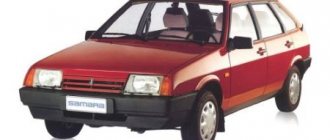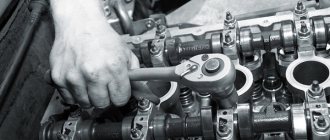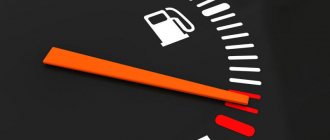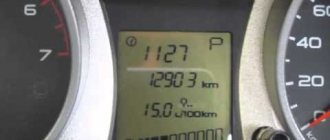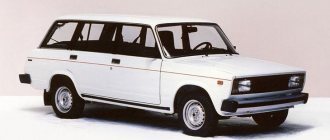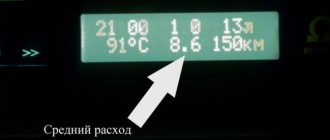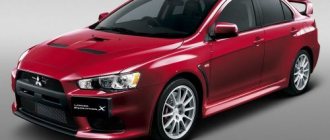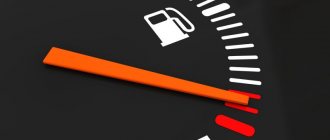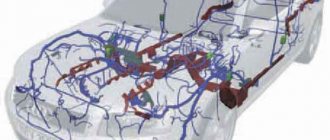Every car owner, as soon as he has purchased a car, is faced with the fact that the largest expenditure of money from that moment goes on purchasing gasoline, and not on repairs and service stations. In this article we will look at the technical characteristics, features of fuel consumption for manual and automatic transmissions, what is associated with higher fuel consumption, and also how you can save gasoline consumption for the Lada Kalina.
The manufacturer claims that the fuel consumption of the Lada Kalina ranges between six and seven tenths and seven and six tenths liters per 100 km. This figure includes the gas mileage of the Lada Kalina sport, hatchback and station wagon. This is exactly how it is written in the technical characteristics of the car. Based on these data, the most economical option is with a VAZ-21127 engine with a power of one hundred and six horsepower and a manual transmission. At the same time, the most uneconomical option is the Lada Kalina with an automatic transmission: it has the highest fuel consumption.
The main reasons for high fuel consumption on the Lada Kalina
There are quite a few reasons, but in this article we will try to consider them all. This is primarily due to improper operation of the vehicle and untimely maintenance. So, what are the reasons for the high fuel consumption of the Lada Kalina:
It's time to change this air filter
Condition of the candles in the photo
The photo shows a not very dirty BDZ, it can be worse
All these reasons can be a consequence of increased fuel consumption on the Lada Kalina.
How to diagnose problems
13.3 liters per hundred is a lot even for the economical Kalina, even for driving in traffic jams
First, check whether the consumption data on the on-board computer screen is correct. To do this, compare its data with your gas stations! Fuel up to full, record the mileage until the next gas station, and find out the real fuel consumption of your car.
Diagnostics of faults should be carried out step by step until the cause of failure of a particular part that affects the increase in consumption is determined:
Ignition coils are marked with a circle
While checking the compression of the Kalina engine
Elimination methods
To troubleshoot problems, it is necessary to replace broken or failed parts. If the malfunction cannot be resolved, you should contact a fuel specialist; you may need to adjust the injection.
Another troubleshooting option is to flash the control unit firmware. For the Lada Kalina, this is normal practice when errors occur in the ECU (error 4 is a fairly common occurrence). This malfunction can be treated by adding new software to the unit.
Lada Kalina fuel consumption 1.4, 1.6 - 8, 16 valve
Today, such a car indicator as fuel consumption per 100 km is of concern to every owner. The actual value of this parameter does not always coincide with the value declared by the manufacturer in the attached documentation. Interest in this topic is only fueled by ever-increasing prices for fuel resources. Reviews indicate the particular relevance of this issue among the cohort of car owners of domestic origin.
To study this problem in detail, we will consider a model from the budget segment Lada Kalina with a volume of 1.4 or 1.6. The technical aspects of this machine are best suited for a detailed analysis of such characteristics as fuel consumption. The family of “Russian” modifications involves the presence of different body styles and engine configurations. This moment brings maximum objectivity to the issue we are considering.
What factors determine the fuel consumption per 100 km of Kalina? Is it possible to force it down?
According to the degree of “gluttony”, the car is characterized by the following factors:
- quality of refueled fuel;
- technical condition of the power plant and transmission unit;
- driving style;
- other operating conditions;
- the amount of pressure inside the tires.
Any of the identified aspects can significantly increase fuel consumption per 100 km, and therefore, we will consider each factor individually.
Sometimes owners of LADA Kalina with a volume of 1.4 or 1.6 refuel their iron “horses” at unfamiliar stations, and then suddenly notice that the car’s “appetite” has jumped sharply.
This phenomenon can be explained by the presence of fuel with low quality standards, which is not able to burn completely. As a result, we observe a decrease in the power of the unit. Now, in order to move at an adequate speed, you will need to apply more gas.
Experienced owners can immediately “detect” such a situation, after which they never return to the “offending” gas station.
We act like this. We wait for the fuel reserve lamp in the tank to activate and then fill up our Lada Kalina to capacity. Reset the daily mileage reading in the odometer. We continue the trip without thinking about saving until the previously indicated lamp comes on. Using the brain resource for simple mathematical operations, we obtain the value of fuel consumption. If the consumption level in this case turned out to be higher than stated, then you should continue to search for the reasons.
During the break-in stage, the Lada Kalina engine tends to heat up more than in normal mode. This is explained by an increase in friction between the mutually moving components of the cylinder-piston group. The result of this is an increase in fuel consumption.
A similar result will be demonstrated by a car whose engine “suffers” from oil starvation or lack of quality lubricant.
This aspect should be taken into account, since modern Kalina engines are prone to increased sensitivity to the quality of the oil.
It is very rare for a new car to upset the owner with any malfunction. Another situation is replacing the ECU firmware. The factory software has settings that provide for a running-in mode for the power plant and its further operation under average conditions.
Some owners of Lada Kalina saw at this moment the fact of an increase in fuel consumption. Particularly desperate owners of Kalina “pour” new firmware into the “brains” of their cars, designed to reduce consumption.
Also, a catalyst that has become unusable can provoke the engine to increase in “gluttony.” The consequence is the formation of carbon deposits on the components of the cylinder-piston assembly, which subsequently causes combustion of the mixture in an incomplete volume. The engine “says goodbye” to adequate dynamics, and the on-board controller screen immediately indicates to the owner an increase in consumption.
We would like to draw the attention of those who like to install luggage compartments on the roof. In this case, one can observe a deterioration in the aerodynamic properties of the car, which inevitably leads to an increase in gasoline consumption.
A few words about the suspension. Faulty components also provoke an increase in consumption. Unadjusted brake pads and unlubricated bearings will “ask” the owner to visit gas stations a little more often.
Kalina dashboard
Lada Kalina tire size
Error codes Lada Kalina 1.6 8 valves
When forming the technical indicators of a specific model, the manufacturer draws data from test results at testing grounds. These conditions differ significantly from the actual situation of subsequent operation.
A considerable proportion of owners are prone to driving at high speeds and aggressive driving style. Fuel consumption inevitably increases, and the face of the temperamental driver becomes covered with surprise, turning into despondency.
Also, not the best way to save money is to hold back the engine or the so-called “tight” driving.
In winter, consumption increases due to the need to warm up the engine for a longer time. Turned on comfort systems (heating, stove, etc.) create the same preconditions for excessive waste of gasoline. Note that in summer gluttony also increases due to a running air conditioner.
Recently, the Lada Kalina has been “honored” of the opportunity to be equipped with an automatic transmission unit. Here, the owner’s leverage over the level of consumption is almost taken away, since the “brain” of the box independently determines the moment of transition to a specific level. Owners of such Kalinas can often be found on online forums, where they, in search of the truth, try to find out: why do their cars “eat” a lot?
A reduced pressure can lead not only to high fuel consumption, but also to a significant deterioration in driving performance. The LADA Kalina car “gains heaviness”, and its roll-up is significantly reduced. The engine begins to experience additional load, and therefore fuel consumption increases.
Let's sum it up
Note that on the Internet you can find a lot of complaints about the inadequate high fuel consumption in LADA Kalina cars, both 8-valve and 16-valve. After much discussion and reflection, many owners of a practical “Russian car” agree with the statement that the level of consumption is, first of all, a subjective concept. You can fight gluttony, the main thing is to take into account the aspects we have outlined.
Lada Kalina is a small class car developed and produced by the Russian company AvtoVAZ. Work on his project began back in 1993. Then it did not have its current name. The model received its real name later in 1998, when “Kalina” was added to the “Lada” prefix in honor of the chief designer A.S. Viburnum.
In the period from 1999 to 2001, presentations of the Lada Kalina took place in hatchback, sedan and station wagon versions. Production of the first cars began in 2004, 11 years after the start of development. Over the years, two generations of the Lada Kalina car have been produced.
Moreover, the model range of the first was produced for quite a long time, after which only in 2013 the second generation Kalina was presented to the world.
pages
- 1 Lada Kalina 1st generation
- 2 Lada Kalina 2nd generation
Fuel consumption rate per 100 km
In the first two years, AvtoVAZ had to recall a number of cars back to the plant for modification and repair due to a defect in the assembly. This happened three times: due to a defect in the steering column, incorrect casting of the steering housing and a defect in the engine mounts. In the basic configuration, the standard power unit was a 1.0 displacement engine.
6 liters with 81 hp The maximum speed to which such a car accelerates is 160 km/h, and its consumption is 10.2 liters in the city and 6.6 liters on the highway. Later, a 1.4 89 hp engine was added to it. and 1.6 98 hp The maximum speed of such units is 160 and 183 km/h, respectively. Consumption per 100 km in the city is 9.6-9.7 liters and on the highway 6.3-6.
4 liters.
Real gas consumption
- Dmitry, Vologda. Lada (VAZ) Kalina 1.6 MT 2009 When I took the car, of course, I didn’t expect anything supernatural, since I know our auto industry quite well. But I didn’t expect such shortcomings either. During the first thousand kilometers the horn broke. The build quality couldn't be worse. And the consumption is a bit high - 10-11 liters in the city, 7 liters on the highway.
- Sergey, Kursk. I originally bought the car for my mother’s dacha, but later I got behind the wheel. Overall not bad, but too many shortcomings, although roomy. After a month and a half, the doors began to creak terribly. Now the steering rack has already started to act up. The engine is good, its consumption is 8.5 liters per 100 km. Our model is 2007 with a 1.6 MT engine.
- Valery, Moscow. 3 years after the purchase, I can say that Kalina is a good car. Especially with such a configuration for such money (1.4 MT engine, manufactured in 2011). The interior is spacious and the paint job is also good. The only bad thing is that the trunk lid closes tightly, with some effort. Plus, the rubber bands on the doors are bad - they leak when it rains. Consumption in the city is 10 liters, on the highway 6.5-7 liters.
- Alexander, Ufa. Lada Kalina 1.6 MT 2006. The car is good only in terms of engine and spaciousness. Its consumption is average - it consumes up to 7 liters per 100 km on the highway. In the city, in quiet mode, 10-10.5 liters are consumed. In terms of reliability, everything is bad here. In the first six months I stood up on the highway 5 times. I had to pull it on a rope.
- Victor, Samara. I’ve been driving my Lada Kalina I for seven years now (I bought a new one from 2006 with a 1.6 MT engine). During all this time, only the generator and reverse gear broke down. And it didn’t let me down anymore. The engine is good, pulls well. Fuel consumption per hundred is on average 8-9 liters. The bottom is also done well, although the silencer has begun to rot a little. The noise could have been done better.
- Leonid, Chelyabinsk. I like the car in every way. A lot of advantages. Kalina's engine is powerful, and the consumption is low - on the highway at 110 km/h 8 liters, in the city 10 liters (1.4 MT engine, year of manufacture - 2009). The salon and the view from it are excellent. The steering wheel holds well. Disadvantages include poor sound insulation and a battery that broke after six months. They say it was defective.
- Andrey, Tolyatti. Lada (VAZ) Kalina 1.6 MT 2009. On the highway, the Lada behaves with dignity. Plus, I went into the forest and off-road there. In general, cross-country ability is also good. But its consumption is a bit high: in winter in the city it’s 12 liters, on the highway 7-8 liters. The big drawback is the box, which began to make quite a lot of noise. Soon we'll see what the reason is.
- Sergey, Yaroslavl. For the entire time I have owned Lada Kalina I, I have only good impressions. There were no breakdowns, except that the low beam lamps burned out. Consumption is also good. For a hundred kilometers on the highway at 120 km/h no more than 7 liters, taking into account both the air conditioner and the stove. In the city within 9-10 liters. I bought a used one from 2008 with a 1.4 liter engine.
- Nikolay, Kyiv. Lada (VAZ) Kalina 1.4 MT 2012. If we take all VAZ brand cars, then Kalina is the best. I really like the spacious interior and the fact that it has never broken down in three years. The engine is playful, but gluttonous, and eats a lot of oil. Gasoline consumption is also quite high - 10-11 liters in the city and 8 liters on the highway. And it's a cool car.
- Andrey, Stavropol. When choosing a car, I was guided by the price-equipment ratio. As a result, I took the first generation Kalina (2008) with a 1.6 liter engine. Pros - the design and interior of the car, fuel consumption - in the city with traffic jams 10 liters, and on the highway about 6.5 liters. The disadvantages include the box and sound insulation. In addition, after 2 months the interior began to creak.
- Sergey, Kemerovo. Lada (VAZ) Kalina 1.6 MT 2009. I have been driving my car for about 6 years. The first good thing about it is that it is inexpensive, and they will serve you anywhere. The consumption was also impressive, since it does not quite correspond to the official data - 7 liters in the city, 6 liters on the highway. The disadvantages include noise and creaks in the cabin, which indicates poor build quality.
conclusions
If the on-board computer shows significantly more than 8.5 liters (and this is the average consumption in mixed mode), then this is a reason to think about the proper operation of the engine and its systems
If an increase in fuel consumption is detected on the Lada Kalina, the malfunction should be immediately diagnosed and repaired. There were cases when consumption reached 20 liters and only after that did motorists begin to do something. If the owner of a Lada Kalina cannot detect the fault himself, then it is worth contacting a car service center. The consequence of increased consumption may be increased wear of the elements of the power unit, which can lead to unplanned overhauls.
Source
About the real fuel consumption of Lada Kalina
The fuel consumption indicated by the manufacturer may differ significantly from the readings observed by the owners of this car. Let's find out what gasoline consumption of the Lada Kalina is indicated in the instruction manual and what real figures are observed by car enthusiasts.
The technical characteristics of Kalina (sedan, station wagon, hatchback or sport) indicate “ Fuel consumption by driving cycle, l/100 km ”:
To determine the real fuel consumption on Kalina 1.4, we analyzed reviews from owners. As a result, it turned out that:
Fuel consumption for Kalina 1.6 will be slightly higher, the average is 9/6.8/8 for city/highway/mixed. Why do some people have high fuel consumption in their Lada Kalina, while others have much less? There may be several reasons, here are the main ones:
Lada Kalina 2004 - 2013
First cars
The first production sedan was equipped with a 1.6-liter eight-valve engine. The production of this engine was well tested and familiar. It almost completely, with minor improvements, repeated the design of the power unit of the VAZ G8, but only its volume increased. Power 82 hp enough to complete the assigned tasks - driving in city traffic and driving on the highway at the speed allowed in Russia.
New bodies and engines
Since 2006, cars with a hatchback body began to roll off the assembly line, and in 2007 a station wagon appeared. The evolution of power units was continued by a motor with the same volume, but with a 16-valve mechanism. The car's power has increased, and so has its acceleration dynamics. Unfortunately, the fuel consumption of the Lada Kalina often exceeded the figures stated by the manufacturer. They tried to reduce it by reducing the engine volume from 1.6 to 1.4 liters. Power dropped by 20 hp. s., but the new engine actually consumed less gasoline.
Gearbox and features of the first generation
All Kalinas until 2013 were equipped with a 5-speed manual transmission. The fuel injection and ignition processes are controlled electronically. During its release, the model acquired an anti-lock brake system, electric power steering and air conditioning, which was installed on upgraded cars.
Fuel consumption depending on engine
- The 8-valve engine with 1600 cc capacity is characterized by low power but excellent torque. When the load increases, there is often no need to downshift. The advantage is that damage to the timing belt will not cause the valves to collide with the pistons, and they will not be deformed. The downside is that it is noisy during operation. When driving on the highway at a speed of 90 km/h, the claimed consumption is 5.5 liters per 100 km.
- The 1.6-liter power unit, equipped with sixteen valves, is significantly more powerful than its predecessor, but its thrust has decreased. It is more capricious in terms of fuel and oil, its maintenance and repairs are more expensive. True, it also consumes less gasoline: according to the manufacturer, consumption on the highway is about 5 liters, in the city - 7 liters, mixed - 6 liters. The actual figures are slightly higher. The main reason for greater efficiency with increased power is better efficiency when consuming the fuel-air mixture, faster fuel supply to the cylinder and exhaust gas output.
- The most economical is the smaller engine with 16 valves. The revolutions have increased to 4.5 thousand per minute, but driving with a load in high gear is unlikely to be possible. If the timing belt breaks, there is a risk of bending the valves, and this will affect the cost of repairs.
| Modification | 1.6, 8 grades, 5 grades. Manual transmission | 1.6, 16 grades, 5 grades Manual transmission | 1.4, 16 grades, 5 grades Manual transmission |
| Consumption city, l/100 km | 7,7 | 9,8 | 8,5 |
| Route, l/100 km | 5,5 | 6 | 5,5 |
| Combined cycle consumption, l/100 km | 7,5 | 7,2 | 7,5 |
| Acceleration, sec up to 100 km/h | 13,5 | 12 | 12,5 |
Factory standard fuel consumption indicators for Lada Kalina
There are four main models of the Lada Kalina passenger car:
As you can see, the main difference between each model is its body type. Gasoline consumption (unleaded AI-95) is calculated in liters over a driving cycle, which is 100 kilometers.
In this case, the following parameters of the vehicle itself are taken into account:
Experts have prepared an information table that shows the factory fuel consumption indicators for each model of the Lada Kalina passenger car, taking into account the mandatory parameters.
Model Lada Kalina
The manufacturer sets the standards for digital fuel consumption indicators for each Lada Kalina model based on the results of test runs of passenger cars on a special track. But on the track, driving conditions are reduced to ideal, and the car is driven by an experienced driver. In real conditions, everything becomes much more complicated. In addition, the speed indicator during real driving is not always within the required limits - from 100 km/h to 120 km/h. This is due to the fact that some drivers do not recognize the established framework for optimal driving of a Lada Kalina car, which significantly affects fuel costs.
What determines fuel consumption?
There are many factors influencing fuel consumption, all of them in some way are ways to radically change fuel consumption. The larger the engine volume and the more powerful, the greater its fuel consumption, that is, it is necessary to take into account the technical parameters of the car, even its weight can affect this.
Vehicle factors affecting fuel consumption:
- Engine capacity;
- Engine power;
- Wheel size;
- Vehicle weight;
- checkpoint;
- Drive (full or mono);
- Engine wear;
Consumption is also significantly affected by other parameters, such as weather conditions or additional electrical equipment. For example, with the air conditioning on, the load on the engine increases and more fuel is needed to ensure normal vehicle dynamics. Turning on heated seats, heated glass and even headlights are ways to increase consumption, not to mention the cold. In cold weather, the car experiences enormous loads, which leads to greater fuel combustion due to prolonged warm-up of the power plant.
Real fuel consumption of Lada Kalina (according to reviews from car owners)
Many car owners of the Lada Kalina passenger car complain that in reality, gasoline consumption indicators differ from those specified by the manufacturer. For comparison, let’s look at another information table prepared by specialists taking into account feedback from Lada Kalina car owners.
When comparing two information tables, it is clear that the real figures are indeed higher than the stated factory fuel consumption standards for the Lada Kalina. What are the reasons for this discrepancy between the figures?
High fuel consumption on Kalina
Consumption of 13-15 for 8kl is far from the norm.
My consumption in the city was 14-15 liters, it was infuriating and annoying to feel as if you were driving a shnivy.
I measured the mass air flow sensor and there were deviations from the norm. 1.04 I think. Replaced, cleaned the Throttle, IAC, replaced the fuel filter, the spark plugs were fine with a mileage of 3-4 thousand.
And that’s it, a miracle happened - the consumption was 8.5-9 liters. I pour 95 gasoline on Luk-le. The firmware is factory installed, no need to flash anything. Check and replace consumables.
Before sewing a car, a normal diagnostician does diagnostics (included in the cost of sewing), you never know.
Here in Kazan they give a two-week guarantee; if you don’t like it, you can come and update the firmware that was installed and the money will be returned in full.
I stitched it for 1,500 rubles. I advise you to download the firmware from “Icebreaker” or “Paulus”. I filled it with the last one and didn’t regret it a bit. The consumption is less and the dynamics are higher.
Check the mass air flow sensor during diagnostics, it will be immediately obvious.
And in cold weather, the normal consumption for this engine is 12.5-13 liters with warm-ups (maybe you just warmed it up a lot).
In general, if you want to reduce consumption, then install a 4-2-1 pack, then forward flow on 51 pipes, a FOX resonator, a can too (it could be a little more expensive from a Honda), a larger throttle, a zero filter in a standard housing and do online firmware. I think that the consumption will be reduced by 1.5-2 liters (in general, the Kalinovsky engine is very strangled).
I began to notice that fuel consumption has increased significantly, at speed 5 I used to go from 6.8 to 8.5, but now the pedal goes beyond 10k, I try not to press, but even then the speed drops, the average speed is 100 km per hour on the highway, if I press the pedal a little on the on-board vehicle, the consumption shows 9.6 and higher.
Everything works stably, I don’t count the warm-up period, I reset the average consumption before the trip.
I use 95 whenever possible, but at the moment it’s 92, I didn’t notice much of a difference in consumption, I refuel at one gas station.
The fuel filter was also changed in September and the pump screen was changed. I changed the spark plugs in May 13 NGK. Engine 1.6 8kl.
On the highway I have from 5.5 to 7 liters. And in the city it’s from 8.5 to 13 liters, or even more.
Moreover, if you start driving on a not warmed up engine, the average consumption is higher. The experiment lasted two weeks, for a week I warmed up the engine to about 60 degrees and drove, and then a week after starting it, I waited 30 seconds and drove. Mileage approximately 150 km. it turned out, and the consumption when warmed up was 9 liters. On cold 11.5l.
So even such a trifle depends on how much!
No, what do you want? The engine is strangled by the catalyst.
When I bought my swallow, I was simply stunned by its appetite; on the highway I didn’t eat less than 7.5 liters, and in the city, even in the summer, about 10 liters, and in the winter I got up to 12.
I went to the services and asked me to do something, but everyone waved me off and said to calm down.
Then, when I tuned the engine a little, the consumption remained the same and the horses increased (and this is on large valves, on a 52 camshaft and Volga injectors).
I think that if you install a spider 4-2-1 shaft, leave the original one and do online firmware, then the consumption can be reduced...
Only registered and authorized users can leave comments.
Source
Standard consumption
According to the passport, Kalina in a mixed cycle in the city consumes:
- 7 liters of gasoline per 100 km with a 1.4 liter .
- 7.2-7.8 liters for 1.6 liter .
Real data
- Engines with a volume of 1.4 liters consume about 8.4 liters of fuel in the city. On the highway, consumption is 6.2 liters. In the mixed cycle - about 7.3 liters . These figures were obtained using AI-95 gasoline.
- 1.6 liter engines consume a little more. In the city - 9 liters , and on the highway - 6.8 liters . Accordingly, in a mixed cycle the consumption is about 8 liters .
Winter period
Winter fuel consumption increases significantly during snowfall - the flow speed decreases and, as a result, you have to drive in lower gears.
In winter, the indicator depends on the warm-up time. There is also an empirical dependence on air temperature. The colder it is outside, the more difficult it is for the engine to work (the mechanisms and belts are “oak”).
Our consumption is no less than 10 liters per 100 km . This is on a 16- valve engine with a power of 98 hp .
Thus, the factory figures are slightly underestimated. But in general, Kalina can be considered an economical car.
conclusions
If the on-board computer shows significantly more than 8.5 liters (and this is the average consumption in mixed mode), then this is a reason to think about the proper operation of the engine and its systems
If an increase in fuel consumption is detected on the Lada Kalina, the malfunction should be immediately diagnosed and repaired. There were cases when consumption reached 20 liters and only after that did motorists begin to do something. If the owner of a Lada Kalina cannot detect the fault himself, then it is worth contacting a car service center. The consequence of increased consumption may be increased wear of the elements of the power unit, which can lead to unplanned overhauls.
Source
